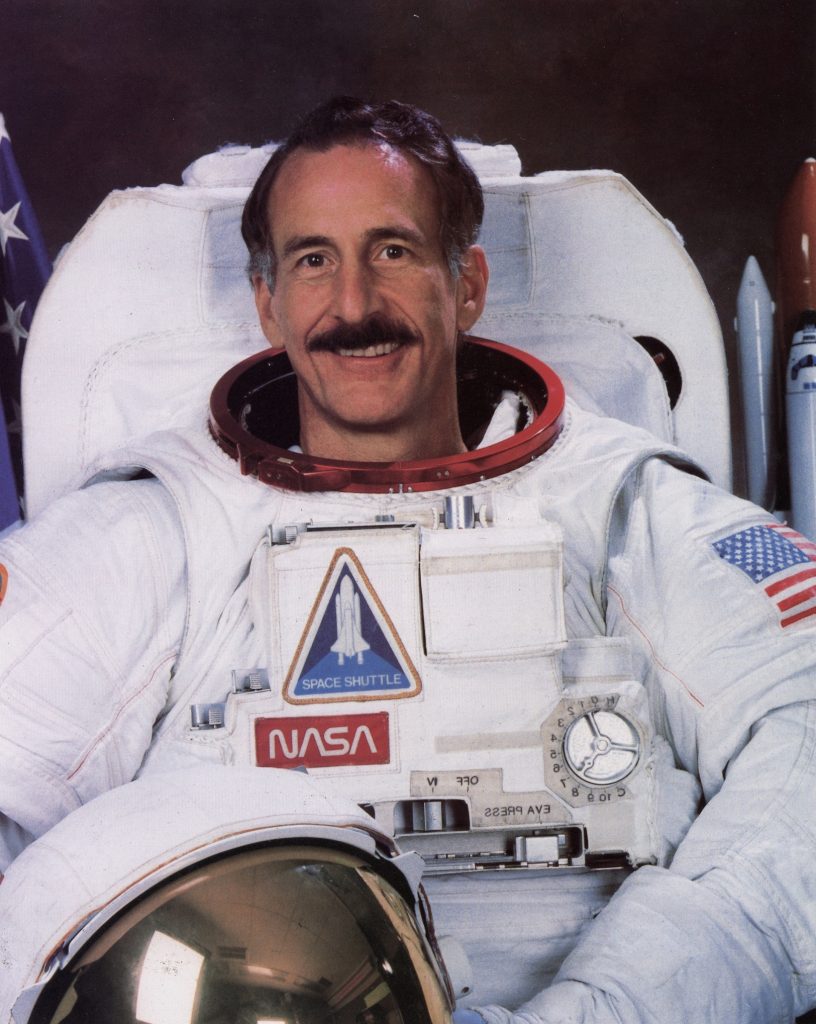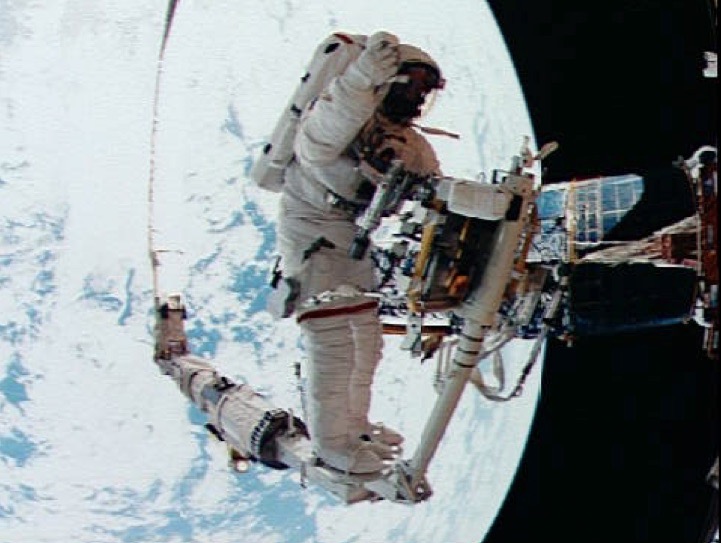Explanatory Note: Prior to joining the faculty of MIT’s Aero/Astro Department, I was a NASA astronaut for 19 years. I was contacted earlier this year by Emeritus Professor Jonathan King, who had heard about my astronaut career. He told me that he had been unaware that an astronaut was a member of the MIT faculty and thought that most faculty and staff at MIT were similarly unaware. As chair of the Editorial Board of the Faculty Newsletter, Professor King invited me to write the following article about my astronaut career and how I came to MIT.

I joined MIT’s Department of Aeronautics and Astronautics at the beginning of the 2001 fall semester, but this was not my first position at MIT. From 1975 to 1978, I worked as a research scientist in the X-ray astronomy group at the Center for Space Research (now the Kavli Institute). I had completed my PhD at Harvard in high-energy astrophysics and spent three-and-a-half years doing X-ray astronomy research in the Physics Department at Leicester University in the UK. During that time, I met and married my wife, Barbara, and our first son was born just 10 weeks before we traveled to Boston for the beginning of my work at MIT.
I was a young boy in the 1950s, when “the coming of the space age” was a regular topic in newspapers, magazines, and TV. My parents often took me to the Hayden Planetarium in New York City, which whetted my interest in astronomy. My undergraduate (Amherst College ’66) and graduate school time coincided with the beginning of NASA’s human spaceflight program. Watching the exploits of the Mercury, Gemini, and Apollo astronauts, I imagined how exciting it would be to go into space, but I realized that these astronauts were all military pilots, which was not a profession I was aiming for. Astronomy may have been in a sense a parallel way of working in space. I was interested in high-energy astrophysics, X-ray and gamma ray astronomy, which were brand new fields back then, and I knew that every time astronomers opened a new portion of the electromagnetic spectrum it led to exciting new discoveries. Also, because this high-energy radiation does not penetrate the atmosphere, we had to launch our telescopes in high-altitude balloons, which I did for my PhD, in sounding rockets, which I did at Leicester, or in satellites, which I did at MIT. I was at least sending instruments into space, even if I couldn’t go there myself.
It was, indeed, an exciting time in X-ray astronomy, and after three years of productive research I was nearing the point in my career to consider looking for a tenure-track faculty position. This never happened, however, because while I was working at MIT, NASA was building and testing the then brand-new Space Shuttle. One critical difference between the Shuttle and previous spacecraft was that the Shuttle could take a crew of seven, and it only needed two pilots. So, when NASA put out its first call for astronauts to fly on the Space Shuttle, they specifically said that in addition to pilots, they were looking for qualified scientists, engineers, and medical doctors.
It was a “wow” moment when I realized that I could legitimately apply to be an astronaut, so I did, along with 8,000 other people. I was fortunate enough to be one of the 35 selected as the first Space Shuttle astronauts.
It turned out that four of us were astronomers, including Sally Ride, which made us very happy, since astronomy is a relatively small science, but there were more astronomers in our group than from than any other science. The influx of so many non-military pilots changed the complexion of the Astronaut Office, and, of course, becoming an astronaut completely changed my life. I put aside my academic aspirations and moved to Houston in the summer of 1978, where we lived for 19 years.
My first space flight was originally scheduled for June 1984; however, in those early days of Shuttle flights, cancellations and crew switches were common. We were bumped from the June flight due to an earlier flight cancellation and subsequent crew reassignment, and the next two flights we were assigned to both ended up being cancelled. We finally flew in April 1985 on our fourth assigned mission. It turned out that the flight was worth waiting for, however, as one of the two telecommunications satellites we deployed failed to activate, and Mission Control sent me and my EVA (extra-vehicular activity = spacewalk) partner outside on NASA’s first ever unplanned, contingency spacewalk in an attempt to repair the satellite. The view through the Shuttle’s windows is amazing, but being outside in a spacesuit is a whole different experience of being in space.
My second space flight, where I was one of four PhD astronomer-astronauts operating an ultraviolet observatory, would have been the next flight after the Challenger disaster, but all flights were cancelled for several years, and we finally flew in December 1990. My third flight was the initial attempt to deploy the U.S.-Italian Tethered Satellite, which was designed to be deployed from the Shuttle but remain attached by a 20-km electrically conductive wire. We planned to study tether dynamics and plasma physics, but mechanical problems prevented us from deploying the tether more than a few hundred meters. At one point, the tether became jammed, and we started preparations for what would have been another unplanned EVA to pull in the tether manually. Alas, Mission Control came up with an alternative way to retrieve the tether, and we stayed inside.
The most significant thing I accomplished as an astronaut was no doubt repairing the initially flawed Hubble Space Telescope, in December 1993.
NASA took all measures possible to reduce the risk of failure for this critical mission, including the requirement that only people who had previously done spacewalks could be on the Hubble EVA crew, and due to the unplanned EVA I had done on my first flight, I had my “EVA union card.” Being on the Hubble rescue mission was particularly moving for me as an erstwhile astronomer, since many of my former astronomy colleagues had devoted years of their lives to the Hubble project and often contacted me during our training for reassurance that we might actually be able to fix Hubble’s problems. As everyone knows, despite being the most complex Shuttle mission NASA had ever attempted, the mission was completely successful, and Hubble has gone on to be NASA’s most productive science mission ever, providing the public with glorious images and rewriting astronomy books many times over.

I had one more flight after the Hubble mission – a reflight of the Tethered Satellite. We were able to deploy it to almost 20 km, when a short circuit caused electrical sparking that melted the tether’s Kevlar strands, causing it to break. Before the break, however, I was treated to an incredible view of the wire stretching upwards and disappearing into the sky. I felt like Jack looking up at the beanstalk! On this flight, I became the first astronaut to log 1,000 hours on the Space Shuttle.
Following my fifth space flight, I was offered the choice of staying in Houston and flying once or twice more to work on the initial construction of the International Space Station or going to live in Paris for four years to work at the U.S. Embassy as NASA’s diplomatic representative for Europe. I love space and would have loved to fly again, but the Paris offer was too tempting to turn down. My wife and I spent a wonderful four years in Paris, where I learned a lot about the European space community and worked to increase cooperation between NASA and our European partners.
During my time as an astronaut and while in Paris, I made periodic visits to MIT to give talks about my work. I had gotten to know Professor Larry Young before I went to NASA, and he ended up spending a lot of time in Houston training to be a payload specialist astronaut. We became close friends, and during several visits to Paris while I was there, he got me thinking about returning to an academic career. Not having done any astronomy research for 25 years, I could not resume my previous scientific work. Fortunately, I had met Professor Ed Crawley, who was Aero/Astro Department Head at the time. He felt that, since the department deals with space flight, it would be good to have someone in the department who had actually flown in space. I was invited to join the Aero/Astro faculty as a Professor of the Practice, where I am still working after more than 20 years.

In coming to MIT, I was excited about being able to work with the best and brightest faculty and students and hoped that I would be able to stay involved with space exploration. That hope has been realized, as I have worked on numerous interesting space projects and am currently Deputy Principal Investigator of the MOXIE oxygen-producing experiment on NASA’s Mars2020 Perseverance rover. (MOXIE = Mars Oxygen ISRU Experiment, where ISRU = in situ resource utilization.) I’ll never get to Mars myself, but it is gratifying to work on an experiment that ultimately will enable human exploration of the Red Planet. At the age of 77, I am fortunate to continue to have challenging and exciting projects to work on. I am grateful to MIT for the opportunity to work here and thank Professor King and the Faculty Newsletter for allowing me to introduce myself to the MIT community.
Editor’s Note: This is the first in a series of faculty self-profiles we plan to feature in the Faculty Newsletter.


